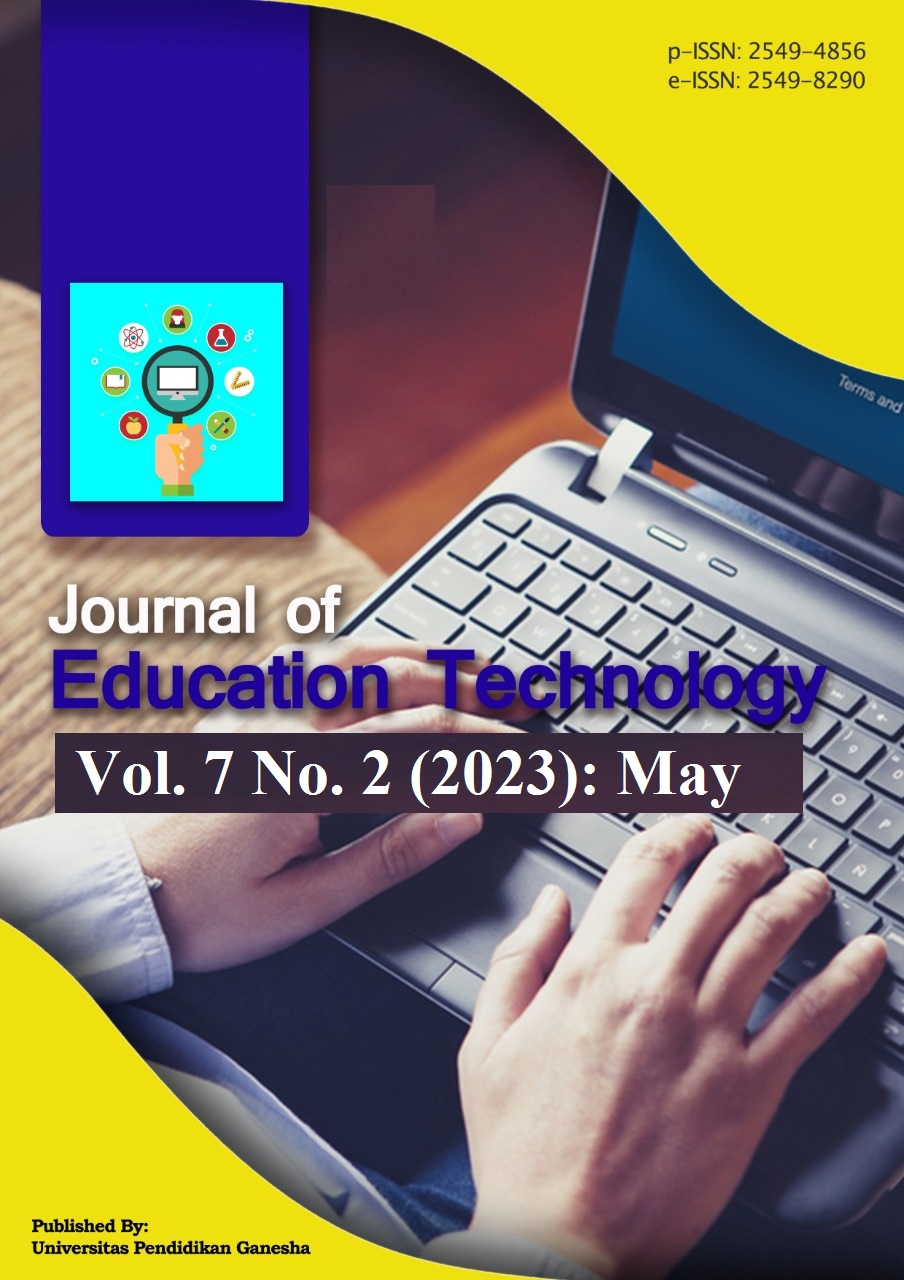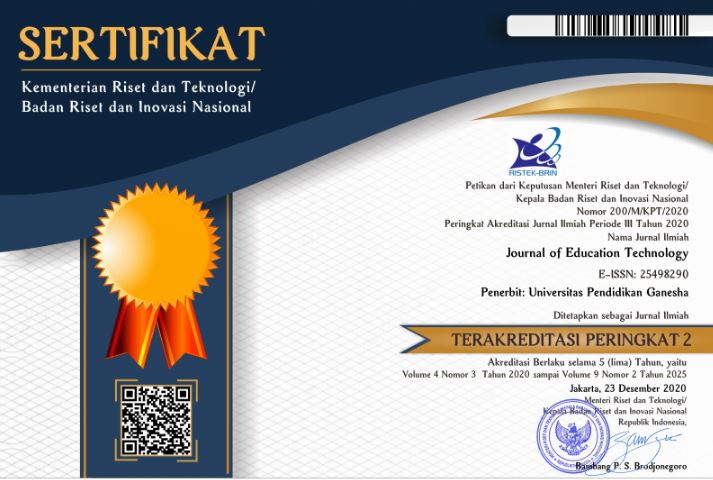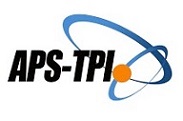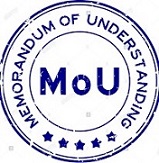Learners Acceptance of u-KIT EDU as an Educational Application for Robot Building, Coding, and Controlling
DOI:
https://doi.org/10.23887/jet.v7i2.58622Kata Kunci:
Robotic, Coding, Technology, Education, ApplicationAbstrak
Humans tend to always look for convenience, including choosing applications to learn robot programming. uKIT EDU is an educational application for robot building, coding and controlling. This study aims to analyze new learners' level of acceptance towards it. This research was designed quantitatively by involving 116 respondents. A questionnaire based on the Technology Acceptance Model (TAM) was organized with 4 observed variables, including perceived usefulness, perceived ease of use, attitude and behavioral intention to use. The Mann-Whitney U statistical test was carried out in this study to compare two independent samples, male and female learners. Moreover, the Kruskal-Wallis H statistical test was carried out to compare three or more independent samples based on age generations and occupations. From all the statistical tests conducted, it was found that there was no significant difference in the acceptance of uKIT EDU from each sample based on gender, age generations and occupation. They agreed that the app was useful and easy to be used to learn robotics, coding and controlling. Briefly, this study revealed that uKIT EDU is suitable for new learners and can be used as a reference for any schools, educational institutions, and parents of students interested in starting to learn robotics.
Referensi
Abdullah, F., Ward, R., & Ahmed, E. (2016). Investigating the influence of the most commonly used external variables of TAM on students’ Perceived Ease of Use (PEOU) and Perceived Usefulness (PU) of e-portfolios. Computers in Human Behavior, 63, 75–90. https://doi.org/https://doi.org/10.1016/j.chb.2016.05.014.
Al-Emran, M., & Granić, A. (2021). Is it still valid or outdated? A bibliometric analysis of the technology acceptance model and its applications from 2010 to 2020. Recent Advances in Technology Acceptance Models and Theories, 1–12. https://doi.org/10.1007/978-3-030-64987-6_1.
Alfadda, H. A., & Mahdi, H. S. (2021). Measuring Students’ Use of Zoom Application in Language Course Based on the Technology Acceptance Model (TAM). Journal of Psycholinguistic Research, 50(4). https://doi.org/10.1007/s10936-020-09752-1.
Almanasreh, E., Moles, R., & Chen, T. F. (2019). Evaluation of methods used for estimating content validity. Research in Social and Administrative Pharmacy, 15(2), 214–221. https://doi.org/10.1016/j.sapharm.2018.03.066.
Arisandi, E. D. (2016). Kemudahan Pemrograman Mikrokontroller Arduino Pada Aplikasi Wahana Terbang. Setrum : Sistem Kendali-Tenaga-Elektronika-Telekomunikasi-Komputer, 3(2), 114. https://doi.org/10.36055/setrum.v3i2.507.
Aristawati, F. A., & Budiyanto, C. (2017). Penerapan Robotika Dalam Pembelajaran STEM:Kajian Pustaka. Prosiding Seminar Nasional UNS Vocational Day, 2, 440–446. https://doi.org/10.20961/uvd.v1i0.15854.
Asri, Y. N. (2018). Pembelajaran Berbasis Stem Melalui Pelatihan Robotika. WaPFi (Wahana Pendidikan Fisika), 3(2), 74. https://doi.org/10.17509/wapfi.v3i2.13735.
Azhar, K. A., & Iqbal, N. (2018). Effectiveness of Google classroom: Teachers’ perceptions. Prizren Social Science Journal, 2(2), 52. https://www.ceeol.com/search/article-detail?id=940663.
Berkup, S. B. (2014). Working with generations X and Y in generation Z period: Management of different generations in business life. Mediterranean Journal of Social Sciences, 5(19), 218. https://doi.org/10.5901/mjss.2014.v5n19p218.
Cai, Z., Fan, X., & Du, J. (2017). Gender and attitudes toward technology use: A meta-analysis. Computers & Education, 105, 1–13. https://doi.org/10.1016/j.compedu.2016.11.003.
Chen, N., Lin, W., & Yan, D. (2020). Building block steering gear robot product design and optimization direction. Proceedings - 2020 5th International Conference on Mechanical, Control and Computer Engineering, ICMCCE 2020, 941–944. https://doi.org/10.1109/ICMCCE51767.2020.00206.
Cooper, A. C., & Sánchez, B. (2016). The roles of racial discrimination, cultural mistrust, and gender in Latina/o youth’s school attitudes and academic achievement. Journal of Research on Adolescence, 26(4), 1036–1047. https://doi.org/10.1111/jora.12263.
Faqih, K. M. S., & Jaradat, M.-I. R. M. (2015). Assessing the moderating effect of gender differences and individualism-collectivism at individual-level on the adoption of mobile commerce technology: TAM3 perspective. Journal of Retailing and Consumer Services, 22, 37–52. https://doi.org/10.1016/j.jretconser.2014.09.006.
Faridawati, F. F., Minarto, E., Istiana Wati, I., Sutrisno, S., & Hakim, L. (2020). Pembelajaran Robotik Untuk Mempersiapkan Generasi Muda Menghadapi Revolusi Industri 4.0 Dan Society 5.0. SPEKTA (Jurnal Pengabdian Kepada Masyarakat : Teknologi Dan Aplikasi), 1(2), 85. https://doi.org/10.12928/spekta.v1i2.2826.
Febtriko, A., Yulianti, W., & Rahayuningsih, T. (2019). Pemanfaatan Ubtech Humanoid Robot Sebagai Media Pembelajaran Kepada Guru Menuju Era Revolusi Industri 4.0 Dibidang Pendidikan Untuk Anak Autis Di Pekanbaru Lab School. Jurnal Pengabdian Masyarakat Multidisiplin, 3(1), 42–52. https://doi.org/10.36341/jpm.v3i1.1022.
Gina, W., & Alison, A. (2021). Top 10 global consumer trends 2021. Euromonitor International.
Hong, X., Zhang, M., & Liu, Q. (2021). Preschool teachers’ technology acceptance during the COVID-19: An adapted technology acceptance model. Frontiers in Psychology, 12, 691492. https://www.frontiersin.org/articles/10.3389/fpsyg.2021.691492/full.
Husni, N. L., Handayani, A. S., Prihatini, E., Anisah, M., Sriwijaya, P. N., & Sriwijaya, P. N. (2019). Peningkatan minat anak di bidang robotika. Snaptekmas, 1(1), 116–126. https://jurnal.polsri.ac.id/index.php/SNAPTS/article/view/2026.
Ibrahim, R., Leng, N. S., Yusoff, R. C. M., Samy, G. N., Masrom, S., & Rizman, Z. I. (2018). E-learning acceptance based on technology acceptance model (TAM). Journal of Fundamental and Applied Sciences, 9(4S), 871. https://doi.org/10.4314/jfas.v9i4s.50.
Khan, F., & Vuopala, E. (2019). Digital competence assessment across generations: A Finnish sample using the digcomp framework. International Journal of Digital Literacy and Digital Competence (IJDLDC), 10(2), 15–28. https://www.igi-global.com/article/digital-competence-assessment-across-generations/236671.
Kim, E.-J., Kim, J. J., & Han, S.-H. (2021). Understanding Student Acceptance of Online Learning Systems in Higher Education: Application of Social Psychology Theories with Consideration of User Innovativeness. In Sustainability (Vol. 13, Issue 2). https://doi.org/10.3390/su13020896.
Lai, K., & Hong, K. (2015). Technology use and learning characteristics of students in higher education: Do generational differences exist? British Journal of Educational Technology, 46(4), 725–738. https://doi.org/10.1111/bjet.12161.
Machay, B., Ruiz, C., Contero, N., & Nogales, D. (2022). Assisted Pedagogy: Robot Alpha for Gross Motor Learning in Sublevel I. International Conference on Innovation and Research, 203–215. https://link.springer.com/chapter/10.1007/978-3-031-11438-0_17.
Maghfiroh, S., & Suryana, D. (2021). Media Pembelajaran di Pendidikan Anak Usia Dini. Jurnal Pendidikan Tambusai, 05(01), 1561. https://jptam.org/index.php/jptam/article/view/1086.
Martinez, C., Gomez, M. J., & Benotti, L. (2015). A comparison of preschool and elementary school children learning computer science concepts through a multilanguage robot programming platform. Proceedings of the 2015 ACM Conference on Innovation and Technology in Computer Science Education, 159–164. https://doi.org/10.1145/2729094.2742599.
Mufarola, K., & Murbowo, A. R. (2019). Manfaat Pembelajaran Robotika Untuk Belajar Siswa. Prosiding Seminar Nasional Pendidikan Program Pascasarjana Universitas Pgri Palembang 12 Januari 2019, 407–417. https://jurnal.univpgri-palembang.ac.id/index.php/Prosidingpps/article/view/2552.
Nugroho, A. H., Bakar, A., & Ali, A. (2017). Analysis of technology acceptance model: Case study of Traveloka. Arthatama, 1(1), 27–34. https://arthatamajournal.co.id/index.php/home/article/view/8.
Papadakis, S., & Orfanakis, V. (2017). The Combined Use of Lego Mindstorms NXT and App Inventor for Teaching Novice Programmers BT - Educational Robotics in the Makers Era. In D. Alimisis, M. Moro, & E. Menegatti (Eds.), International Conference EduRobotics 2016 (pp. 193–204). Springer International Publishing. https://doi.org/10.1007/978-3-319-55553-9_15.
Peek, S. T. M., Wouters, E. J. M., Van Hoof, J., Luijkx, K. G., Boeije, H. R., & Vrijhoef, H. J. M. (2014). Factors influencing acceptance of technology for aging in place: a systematic review. International Journal of Medical Informatics, 83(4), 235–248. https://doi.org/10.1016/j.ijmedinf.2014.01.004.
Pisarov, J., & Mester, G. (2019). Programming the mbot robot in school. Proceedings of the International Conference and Workshop Mechatronics in Practice and Education, MechEdu, 45–48. https://www.researchgate.net/profile/Gyula-Mester/publication/337926235.
Purbohadi, D. (2022). Peningkatan Kompetensi Guru pada Pemrograman Robot Artificial Intelligence Artibo. Jurnal Pendidikan Tambusai, 6, 11481–11488. https://doi.org/10.31004/jptam.v6i2.4266.
Rafique, H., Almagrabi, A. O., Shamim, A., Anwar, F., & Bashir, A. K. (2020). Investigating the acceptance of mobile library applications with an extended technology acceptance model (TAM). Computers & Education, 145, 103732. https://doi.org/10.1016/j.compedu.2019.103732.
Reza, M., Puspita, K., & Oktaviani, C. (2021). Quantitative Analysis Towards Higher Order Thinking Skills of Chemistry Multiple Choice Questions for University Admission. Jurnal IPA & Pembelajaran IPA, 5(2), 172–185. https://doi.org/10.24815/jipi.v5i2.20508.
Sefriani, R., & Sepriana, R. (2022). Technology Acceptance Model : the use of E-Study Aplications in. Journal of Education Technology, 6(4), 704–710. https://doi.org/10.23887/jet.v6i4.45457.
Siti, C., Md, L., Nur, L., Binti, D., Mohd, I., Afiq, D., & Tazilah, K. (2021). Application of technology acceptance model (TAM) toward online learning during covid-19 pandemic: Accounting students perspective. International Journal of Business, Economics and Law, 24(1), 13–20. https://www.researchgate.net/profile/mohd-khamar-tazilah/publication/349214593.
Sobri, A. Y., Bafadal, I., Nurabadi, A., & Gunawan, I. (2019). Validity and reliability of questionnaire problematics leadership beginner school principals. The 4th International Conference on Education and Management (COEMA 2019), 250–254. https://doi.org/10.2991/coema-19.2019.51.
Soriano, A., Marín, L., Vallés, M., Valera, A., & Albertos, P. (2014). Low cost platform for automatic control education based on open hardware. IFAC Proceedings Volumes (IFAC-PapersOnline), 19, 9044–9050. https://doi.org/10.3182/20140824-6-za-1003.01909.
Strawhacker, A., & Bers, M. U. (2015). “I want my robot to look for food”: Comparing Kindergartner’s programming comprehension using tangible, graphic, and hybrid user interfaces. International Journal of Technology and Design Education, 25, 293–319. https://doi.org/10.1007/s10798-014-9287-7.
Taber, K. S. (2018). The Use of Cronbach’s Alpha When Developing and Reporting Research Instruments in Science Education. Research in Science Education, 48(6), 1273–1296. https://doi.org/10.1007/s11165-016-9602-2.
Taufiq, M., Ghani, A., Hamzah, M., Ramli, S., Ab, W., Daud, A. W., Rijal, T., Romli, M., Najihah, N., & Mokhtar, M. (2019). a Questionnaire-Based Approach on Technology Acceptance Model for Mobile Digital Game-Based Learning. Journal of Global Business and Social Entrepreneurship (GBSE), 5(14), 24621714. http://www.gbse.my/V5 NO.14 (MARCH 2019)/Paper-199-.pdf.
Vaportzis, E., Giatsi Clausen, M., & Gow, A. J. (2017). Older adults perceptions of technology and barriers to interacting with tablet computers: a focus group study. Frontiers in Psychology, 8, 1687. https://doi.org/10.3389/fpsyg.2017.01687.
Wibowo, T., & Veronica, J. (2022). IT Curriculum for Boot Camp : An Iterative Development In Applying OBE In Computer Science Education for Non-Formal. Journal of Education Technology, 6(4), 598–606. https://ejournal.undiksha.ac.id/index.php/JET/article/download/51343/24581/155984.
Wong, K. T., bt Osman, R., Goh, P. S. C., & Rahmat, M. K. (2013). Understanding student teachers’ behavioural intention to use technology: Technology acceptance model (TAM) validation and testing. International Journal of Instruction, 6(1), 89–104. https://dergipark.org.tr/en/pub/eiji/issue/5138/70018.
Zubaidah., A., Risnawati, R., Kurniati, A., & Prahmana, R. C. I. (2017). Adversity Quotient in Mathematics Learning (Quantitative Study on Students Boarding School in Pekanbaru). International Journal on Emerging Mathematics Education, 1(2), 169. https://doi.org/10.12928/ijeme.v1i2.5780.
Zubaidah, S. (2019). Pembelajaran untuk memberdayakan keterampilan abad ke-21. Seminar Nasional Matematika Dan Sains, 1–18. https://www.researchgate.net/profile/Siti-Zubaidah.
Unduhan
Diterbitkan
Cara Mengutip
Terbitan
Bagian
Lisensi
Hak Cipta (c) 2023 Virgiawan Listanto, Arif, Firman, Santi

Artikel ini berlisensiCreative Commons Attribution-ShareAlike 4.0 International License.
Authors who publish with the Journal of Education Technology agree to the following terms:
- Authors retain copyright and grant the journal the right of first publication with the work simultaneously licensed under a Creative Commons Attribution License (CC BY-SA 4.0) that allows others to share the work with an acknowledgment of the work's authorship and initial publication in this journal.
- Authors are able to enter into separate, additional contractual arrangements for the non-exclusive distribution of the journal's published version of the work (e.g., post it to an institutional repository or publish it in a book), with an acknowledgment of its initial publication in this journal.
- Authors are permitted and encouraged to post their work online (e.g., in institutional repositories or on their website) prior to and during the submission process, as it can lead to productive exchanges, as well as earlier and greater citation of published work. (See The Effect of Open Access)
















